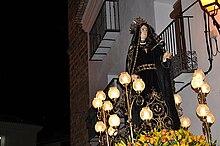
Chipiona is a town and municipality located on the Atlantic coast in the province of Cádiz, Spain. According to the 2012 census, the city has a population of 18,849 inhabitants, but this amount increases greatly during the summer holiday period. The town covers an area of 33 km2. Being in the lower valley of the River Guadalquivir it is very flat with a maximum terrestrial height of 4 metres. It is bordered on the north-west by Sanlúcar de Barrameda and on the south-east by the port of Rota.
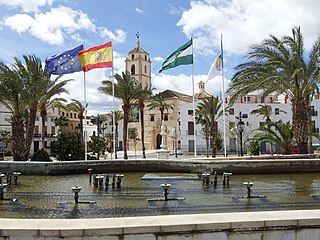
Albox is a Spanish municipality in the province of Almería in the autonomous community of Andalusia. It is situated in the north eastern part of Valle del Almanzora and 120 km from the provincial capital, Almería. In the year 2017 it had 11,481 inhabitants. Its superficial area is 168.42 km2 and it has a population density of 68 inhabitants/km2.
Easter is one of the most significant events in the religious and social calendar, celebrated heavily in the European country of Malta.

Holy Week in Seville is one of two biggest annual festivals in Seville, Andalusia, Spain, the other being the Feria de Abril, which follows two weeks later. It is celebrated in the week leading up to Easter, and features the procession of pasos, floats of lifelike wooden sculptures of individual scenes of sorrowful Mysteries of the Rosary, or images of the grieving Virgin Mary.

Gramalote is a Colombian municipality and town located in the department of North Santander. Currently, the complete destruction of the town is considered imminent due to massive mudslides brought about by unprecedented flooding that most of Colombia has undergone.

Gines is a municipality in the south-west Spain, in the province of Seville, Andalusia. It is part of the metropolitan area of Seville. Gines has a population of 13,529 inhabitants as of 2021 and an area of 2.9 km2 (1.1 sq mi).

El Viso del Alcor is a city located in the province of Seville, Spain. As of 2018, the city has a population of 19,191 inhabitants.

Briviesca is a municipality and a Spanish city located in the north of the Iberian Peninsula, head of the judicial district of Briviesca, capital of the comarca of La Bureba and province of Burgos, autonomous community of Castile and León. According to the demographic data of 2017, the municipality has 6,861 inhabitants, being the 4th most populated in the province. The municipality of Briviesca is made up of five towns: Briviesca, Cameno, Quintanillabón, Revillagodos and Valdazo.
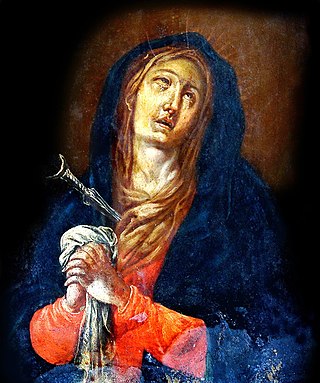
Our Lady of Sorrows of Turumba is a Marian title, a venerated Marian icon and image associated to the Our Lady of Sorrows, The town of Pakil in the province of Laguna considers her as its patroness.
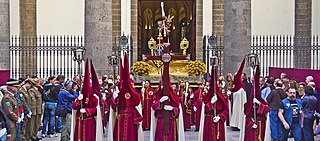
Holy Week in Spain is the annual tribute of the Passion of Jesus Christ celebrated by Catholic religious brotherhoods and fraternities that perform penance processions on the streets of almost every Spanish city and town during the Holy Week –the last week of Lent, immediately before Easter–.

Holy Week is a significant religious observance in the Philippines for the Catholic majority, the Iglesia Filipina Independiente or the Philippine Independent Church, and most Protestant groups. One of the few majority Christian countries in Asia, Catholics make up 78.8 percent of the country's population, and the Church is one of the country's dominant sociopolitical forces.
La Victoria is a municipality in the province of Córdoba, Spain. In the year 2011 its population was 2,336. It has an area of 20 square kilometres (7.7 sq mi) and a population density of 120/km2. It is situated at an altitude of 262 metres (860 ft) above sea level and is 29 kilometres (18 mi) from the capital of the province, Córdoba.
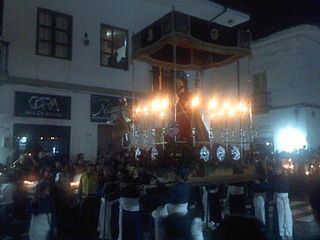
The Holy Week in Popayán, Cauca (Colombia), is the celebration of the Passion and death of Jesus Christ through daily processions continuously performed since the sixteenth century between Friday of Sorrows nights and Holy Saturday. The processions take place in the ancient streets of the "White City". Religious images of Spanish, Andalusian, Quito, Italian and Payanes arranged on a wooden platform with four front and four back "barrotes" (bars) are carried in the shoulders of the "Cargueros". These images are representations of different episodes recounted in the Gospels on the Passion, Crucifixion and Death of Jesus Christ. Each performance is a "paso" (step). The steps are taken through the streets, a distance of a cross-shaped layout since the time of the Conquest, passing by the main churches and temples of the city.

Holy Week in Mexico is an important religious observance as well as important vacation period. It is preceded by several observances such as Lent and Carnival, as well as an observance of a day dedicated to the Virgin of the Sorrows, as well as a Mass marking the abandonment of Jesus by the disciples. Holy Week proper begins on Palm Sunday, with the palms used on this day often woven into intricate designs. In many places processions, Masses and other observances can happen all week, but are most common on , Good Friday, Holy Saturday and Easter Sunday, with just about every community marking the crucifixion of Jesus in some way on Good Friday. Holy Saturday is marked by the Burning of Judas, especially in the center and south of the country, with Easter Sunday usually marked by a Mass as well as the ringing of church bells. Mexico's Holy Week traditions are mostly based on those from Spain, brought over with the Spanish conquest of the Aztec Empire, but observances have developed variations in different parts of the country due to the evangelization process in the colonial period and indigenous influences. Several locations have notable observances related to Holy Week including Iztapalapa in Mexico City, Taxco, San Miguel de Allende and San Luis Potosí.
The Penitential Brotherhood of the Holy Eucharist, founded on May 6, 1959, is one of nine religious brotherhoods of the city of Bilbao that take part in its Holy Week. Bilbao is the most important place for the Holy Week in Spain in the northern part of the country, but not as well known as the Holy Week in Seville. It is canonically headquartered at the Jesuit School, so it is popularly known as the Jesuit Brotherhood. It consists of current and former students, as well as family and friends, but also of people outside the school.

The Friday of Sorrows is a solemn pious remembrance of the sorrowful Blessed Virgin Mary on the Friday before Palm Sunday held in the fifth week of Lent. In the Anglican Ordinariate's Divine Worship: The Missal it is called Saint Mary in Passiontide and sometimes it is traditionally known as Our Lady in Passiontide.
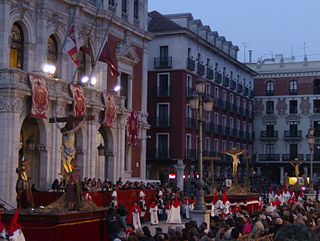
The Holy Week in Valladolid is one of the main tourist attractions, and cultural and religious events of Valladolid and the surrounding province during Holy Week in Spain. It boasts of renowned polychrome sculptures, created mainly by sculptors such as Juan de Juni and Gregorio Fernández, who were active when the city served as the imperial court. The city's National Sculpture Museum has a total of 42 images for the processions. The Holy Week in Valladolid is known to depict the Passion with great fidelity, rigor and detail.

The Procession of Silence in San Luis Potosi is an annual event to mourn the Passion of Christ and honor Our Lady of Solitude. It occurs on the night of Good Friday, beginning at the El Carmen Church, where it originated, and winds through the streets of the historic center of the city of San Luis Potosí. During the event there are the sounds of drums and bugles, but no participant or spectator speaks, giving the event its name. It is one of the most important Holy Week observances in Mexico and was declared part of the cultural heritage of the state of San Luis Potosí in 2013.
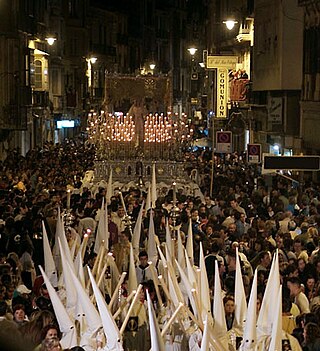
Holy Week in Málaga, is the annual commemoration of the Passion of Jesus in Málaga, Spain. It takes place during the last week of Lent, the week immediately before Easter. It is one of the city's main cultural and religious events.

The Royal and Venerable Confraternity of the Most Blessed Sacrament of Mafra, alternatively, the Royal and Venerable Brotherhood of the Most Blessed Sacrament of Mafra, is a public association of faithful of the Catholic Church, canonically established in the Basilica of Our Lady and Saint Anthony of Mafra, Portugal.


